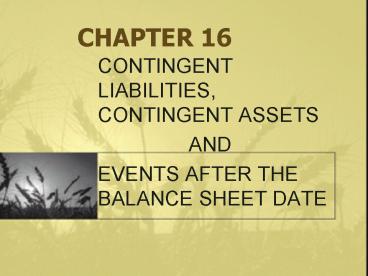CONTINGENT LIABILITIES, CONTINGENT ASSETS - PowerPoint PPT Presentation
1 / 12
Title:
CONTINGENT LIABILITIES, CONTINGENT ASSETS
Description:
A possible obligation that arises form past events and whose existence will be ... or that is has no realistic alterative but to do so ,the financial statements ... – PowerPoint PPT presentation
Number of Views:1673
Avg rating:3.0/5.0
Title: CONTINGENT LIABILITIES, CONTINGENT ASSETS
1
CHAPTER 16
- CONTINGENT LIABILITIES, CONTINGENT ASSETS
- AND
- EVENTS AFTER THE BALANCE SHEET DATE
2
1.IAS37PROVISIONS,CONTINGENT LIABILITIES AND
CONTINGENT ASSETS
- Contingent liability
- -A possible obligation that arises form past
events and whose existence will be confirmed only
by the occurrence or non- occurrence of one or
more uncertain future events not wholly within
the control of the enterprise. - -A present obligation that arises from past
events but is not recognized because
3
- --It is not probable that an outflow of
resources embodying economic benefits will be
required to settle the obligation or - --The amount of the obligation cannot be
measure with sufficient reliability. - Contingent asset a possible asset that arises
from past events and whose existence will be
confirmed only by the occurrence or non-
occurrence of one or more uncertain future events
not wholly within the control of the enterprise.
4
- Accounting treatment depends on the degree of
probability and on whether the contingency is a
potential asset or a potential liability. - IAS 37recognises four degrees of probability for
contingencies, but gives no guidance as to the
meaning of these terms. One possible
interpretation is included in the following table
5
- degree of degree of
contingent contingent - probability probability
liabilities assets - Virtually certain Probability
Provide Recognize - (therefore not above 95
- Contingent)
- Probable Probability
Provide Disclose - above 50 and
by
note - up to 95
- Possible Probability 5 to
Disclose by No disclosure - 50
note - Remote Probability
No disclosure No disclosure - below 5
6
- When there is the possibility of recovery from a
third party of all or part of a contingent
liability ,this must be treated as a separate
matter, and a contingent asset only recognised if
its receipt is virtually certain, as shown in the
table. - When disclosure is made by note should state
- -the nature of the contingency
- -the uncertain factors that may affect the
future - outcome
- -an estimate of the financial effect, or a
statement that - such an estimate cannot be made.
- In the case of a contingent asset, care should be
taken not to give a misleading impression as to
the likelihood of realization.
7
2. IAS 10enents after the balance sheet date
- Events after the balance sheet date those
events, both favorable and unfavourable, that
occur between the balance sheet date and the date
on which the financial statements are authorized
for issue. - Adjusting events those which provide additional
evidence to assist with the estimation of amounts
relating to conditions at the balance sheet date.
Financial statements must be adjusted. - Examples include
8
- -Sales of inventory at less than cost,
necessitating a reduction in the valuation of
closing inventory - -Bankruptcy of a trade customer, requring the
debt to be written off in whole or part - -Amounts received or receivable in respect of
insurance claims which were being negotiated at
the balance sheet date.
9
- Non-adjusted events those which do not affect
the condition of assets or liabilities at the
balance sheet date but are f such importance that
their non-disclosure would affect users
decision-making. Details must be given in a note. - Examples include
- -The issue of new share or loan capital
- -Major changes in the composition of the
- company (for example, acquisitions of new
- business)
- -Financial consequences of losses of
non-current - assets or inventory as a result of fires or
floods.
10
- Proposed dividends it is not acceptable to
include dividends proposed or declared on equity
after the balance sheet date in that balance
sheet as liabilities. - Proposed equity dividends must be shown
- -Either in the notes to the financial
statements - -Or on the fact of the balance sheet as an
appropriation within equity
11
- Going concern status in doubt if, after balance
sheet date, the management of an enterprise
determines either that it intends to liquidate
the enterprise or cease trading, or that is has
no realistic alterative but to do so ,the
financial statements should not be prepared on a
going concern basis. - Date of issue of financial statement the
financial statements should disclosure the date
they were authorized for issue and who gave that
authorization.
12
- Disclosure of power to amend if the owners or
others have the power to amend the financial
statements after issue, that fact should be
disclosure. - Updating of disclosures an enterprise should
update disclosures in the financial statements
that relate to conditions existing at the balance
sheet date in the light of information received
after the balance sheet date.































